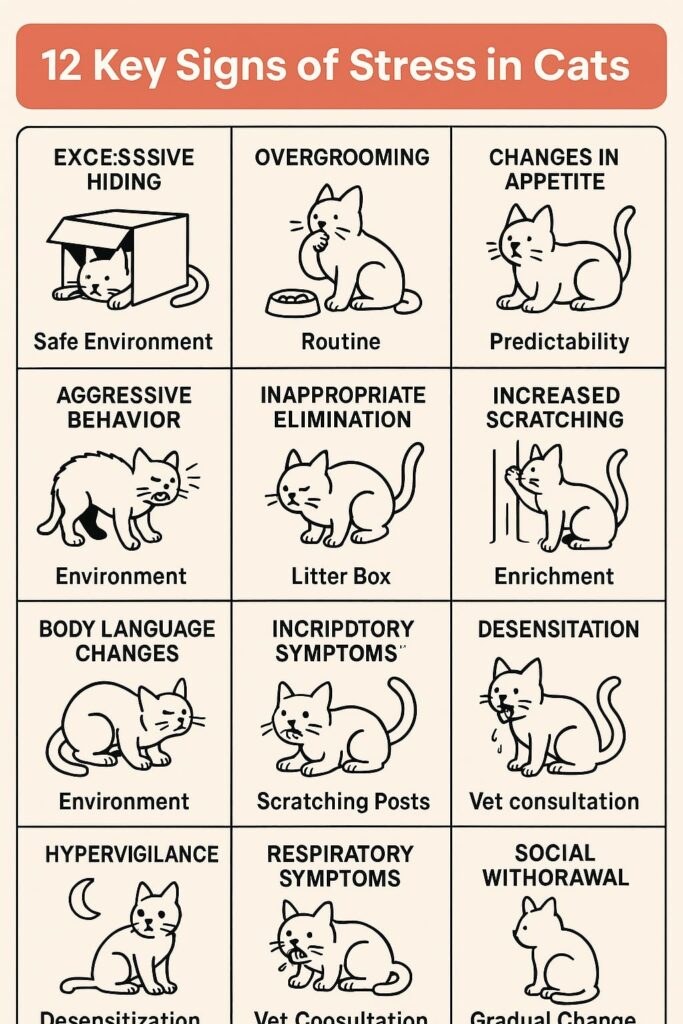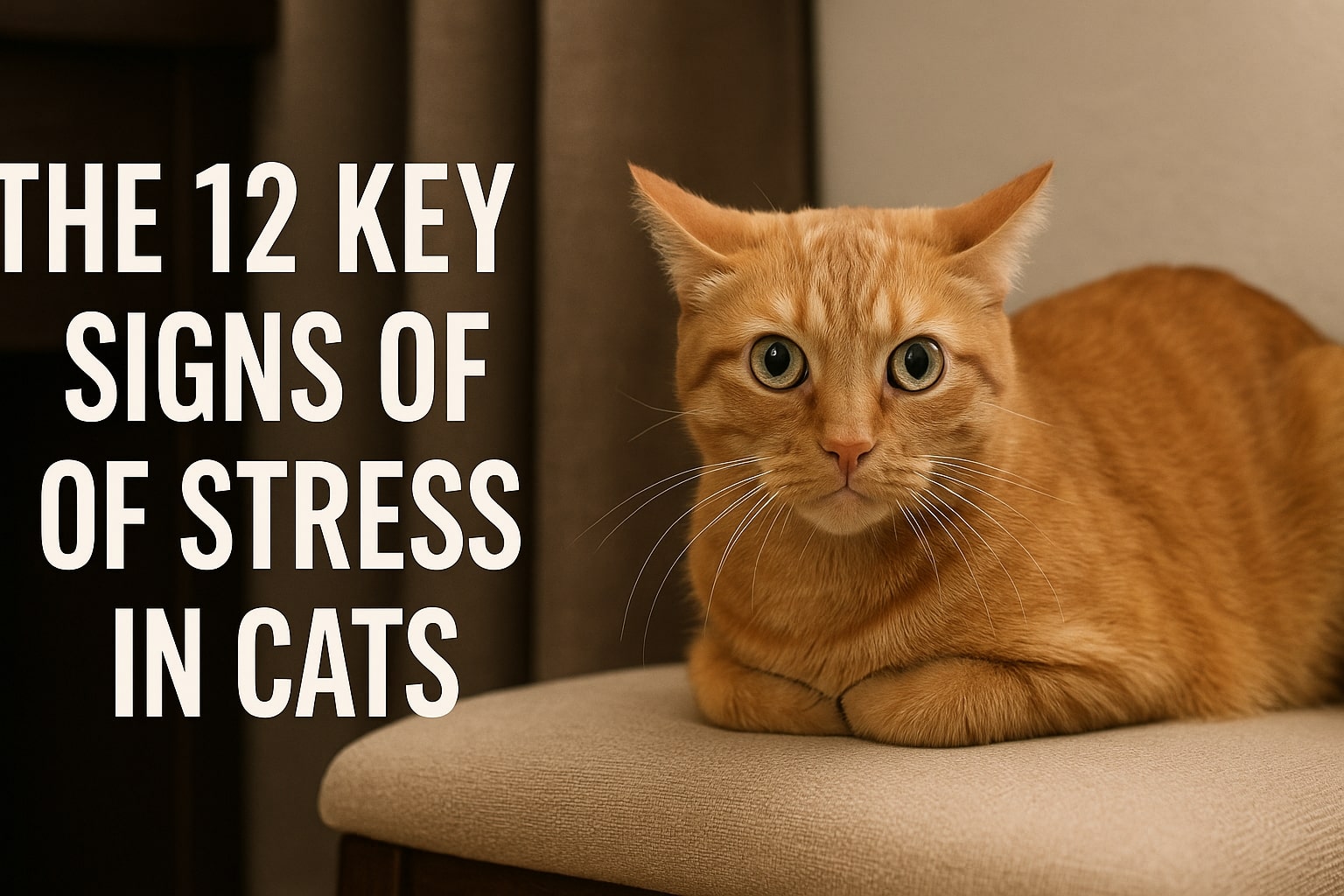Cats are masters of hiding their emotions, making it challenging for even the most attentive pet owners to recognize when their feline companions are struggling with stress. Unlike dogs who wear their feelings on their sleeves, cats display stress through subtle behavioral changes that can easily be overlooked.
Understanding these warning signs and knowing how to respond can make a significant difference in your cat’s overall well-being and quality of life. Chronic stress in cats can lead to serious health complications including urinary tract problems, digestive issues, and a compromised immune system, making early detection and intervention crucial for maintaining your pet’s long-term health.
Understanding Cat Stress and Its Impact
Stress affects cats differently than it affects humans, but the consequences can be just as serious for their physical and mental health. When cats experience stress, their bodies release hormones that prepare them for fight-or-flight responses, which can become problematic when the stress becomes chronic.
This biological reaction served cats well in the wild, but in domestic settings, prolonged stress responses can create a cascade of health problems.
The feline stress response often manifests through changes in behavior, body language, and physical health. Many pet owners mistake these changes for normal aging or temporary mood shifts, but recognizing the patterns can help prevent more serious complications down the road.
Stress in cats typically develops during their first year of life, with most anxiety-related behaviors becoming apparent between 5 months and 1 year of age. However, cats can develop new stress responses or have existing anxieties worsen between 1 and 3 years old, making ongoing observation essential throughout their lives.
The key to managing cat stress lies in understanding that cats are creatures of habit who thrive on routine and predictability. Any disruption to their established patterns, no matter how minor it might seem to humans, can trigger significant stress responses. This includes changes like moving furniture, introducing new family members, altering feeding schedules, or even switching food brands.
The 12 Key Signs of Stress in Cats

1. Excessive Hiding Behavior
One of the most common signs of stress in cats is an increase in hiding behavior beyond their normal preference for quiet spaces. While cats naturally seek out cozy hiding spots for naps and relaxation, stressed cats will hide for extended periods and avoid interaction with family members. They may choose unusual hiding spots like under beds, behind furniture, or in closets, and resist coming out even for meals or favorite activities.
This behavior often stems from their instinct to find safety when feeling threatened or overwhelmed. A stressed cat views their hiding spot as a sanctuary where they can monitor their environment without being vulnerable to perceived dangers.
2. Overgrooming and Self-Harm
Excessive grooming is another telltale sign of feline stress that can escalate into serious health problems. While cats are naturally meticulous groomers, stress can turn this normal behavior into a compulsive activity that results in bald patches, skin irritation, and even open wounds. Stressed cats may focus their overgrooming on specific areas like their legs, belly, or back, creating noticeable thin spots in their fur.
This behavior serves as a self-soothing mechanism, similar to how humans might fidget or bite their nails when anxious. However, when grooming becomes excessive, it can create secondary skin infections and further compound the cat’s stress levels.
3. Changes in Appetite and Eating Habits
Stress significantly impacts a cat’s relationship with food, manifesting in either decreased appetite or, less commonly, overeating. Many stressed cats will refuse their favorite treats, eat significantly less than normal, or stop eating altogether for periods of time. This can be particularly concerning because cats can develop serious liver problems if they go without food for more than a few days.
On the flip side, some cats may comfort-eat when stressed, leading to rapid weight gain and associated health problems. Changes in eating habits often accompany other stress signs and should be monitored closely, especially if they persist for more than a day or two.
4. Increased Vocalization
Cats communicate distress through various vocal expressions, and stressed cats often become more vocal than usual. This might include excessive meowing, yowling, crying, or making sounds that are unusual for your particular cat. The vocalizations may occur at specific times, such as when certain triggers are present, or they may happen throughout the day as a general expression of anxiety.
Some cats become more talkative when seeking comfort or attention during stressful periods, while others vocalize as a way to express their discomfort with their current situation.
5. Aggressive Behavior Toward People or Pets
A normally friendly cat that suddenly becomes aggressive is likely experiencing significant stress. This aggression can manifest as hissing, swatting, biting, or scratching when approached or handled. The behavior may be directed toward family members, other pets in the household, or both.
Stress-induced aggression often occurs because the cat feels cornered or unable to escape from perceived threats. It’s their way of creating distance and establishing boundaries when they feel overwhelmed. This type of aggression should be taken seriously as it indicates the cat is experiencing substantial distress.
6. Inappropriate Elimination
Toileting outside the litter box is one of the most frustrating stress-related behaviors for cat owners, but it’s also one of the most reliable indicators that something is wrong. Stressed cats may urinate or defecate in inappropriate locations, spray urine to mark territory, or avoid using their litter box altogether.
This behavior can stem from several stress-related factors, including fear of approaching the litter box area, anxiety about cleanliness, or territorial concerns if there are other pets in the household. It’s important to rule out medical causes first, as urinary tract problems can also cause inappropriate elimination.
7. Physical Body Language Changes
Stressed cats display distinctive body language that differs markedly from their relaxed state. Signs include a tense, hunched body posture, flattened ears pressed against their head, dilated pupils even in normal lighting, and a tucked tail held close to their body. You might also notice increased swallowing, lip licking, or skin twitching along their back or sides.
These physical manifestations represent the cat’s attempt to make themselves appear smaller and less threatening while remaining alert to potential dangers. The combination of these body language cues provides a clear picture of a cat in distress.
8. Increased Scratching or Destructive Behavior
While scratching is normal cat behavior, stressed cats often scratch more frequently or target new locations like furniture, walls, or carpeting. This increase in scratching serves multiple purposes: it helps them mark territory with scent glands in their paws, provides a physical outlet for anxiety, and creates visible markers of their presence.
Destructive behavior may also extend beyond scratching to include knocking over objects, chewing on inappropriate items, or generally being more reckless with household items.
9. Sleep Pattern Disruptions
Stress significantly affects feline sleep patterns, leading to either excessive sleeping as a form of escape or insomnia and restlessness. Some stressed cats sleep much more than usual, using sleep as a way to avoid dealing with stressful situations. Others experience the opposite problem, becoming hypervigilant and unable to settle into normal sleep cycles.
You might notice your cat pacing at night, seeming unable to get comfortable, or sleeping in unusual locations that offer better vantage points for monitoring their environment.
10. Hypervigilance and Excessive Alertness
Stressed cats often display heightened awareness of their surroundings, constantly scanning for potential threats even in familiar, safe environments. This hypervigilance manifests as an inability to relax, jumping at normal household sounds, or maintaining a crouched, ready-to-flee posture even during quiet times.
This state of constant alertness is exhausting for cats and can contribute to other stress-related behaviors and health problems over time.
11. Respiratory and Physical Symptoms
Chronic stress can cause various physical symptoms in cats, including changes in breathing patterns, increased heart rate, trembling, and excessive salivation. Some cats may pant when stressed, which is unusual behavior for felines and indicates significant distress.
Other physical manifestations include a decline in coat condition, with fur becoming dull, matted, or developing a scruffy appearance. Stressed cats may also experience digestive upset, including vomiting and diarrhea, as well as a general decline in their physical condition.
12. Social Withdrawal and Interaction Changes
Stressed cats often withdraw from social interactions, avoiding family members and becoming less tolerant of handling or petting. A cat that previously enjoyed being picked up or sitting on laps may suddenly resist these interactions or become uncomfortable with normal handling.
This withdrawal extends to their relationships with other pets in the household as well. They may avoid areas where other animals spend time or become less playful and engaging overall.
How to Help Your Stressed Cat?
Creating a Safe Environment
The foundation of stress relief for cats involves creating an environment where they feel secure and in control. This starts with ensuring your cat has access to all essential resources including clean litter boxes, fresh food and water, comfortable sleeping areas, and appropriate scratching surfaces. The location of these items matters significantly, as cats prefer their food, water, and litter box to be in separate, quiet areas away from high-traffic zones.
Providing multiple hiding spots throughout your home gives your cat options for retreat when feeling overwhelmed. These spaces should be easily accessible but offer privacy and security. Cat trees, covered beds, cardboard boxes, or dedicated cat furniture can serve this purpose effectively.
Establishing Routine and Predictability
Cats thrive on routine, so maintaining consistent feeding times, play sessions, and daily activities can significantly reduce stress levels. Even small changes to routine should be introduced gradually when possible. If major changes are unavoidable, such as moving homes or introducing new family members, try to maintain as many familiar elements as possible during the transition period.
Creating predictable patterns helps cats feel more secure and reduces the anxiety that comes from uncertainty about what will happen next in their environment.
Using Calming Aids and Environmental Enrichment
Pheromone diffusers and sprays can be highly effective tools for reducing cat stress. These products mimic natural facial pheromones that cats produce when they feel safe and content, helping to create a calming atmosphere in your home. Place diffusers in areas where your cat spends most of their time for maximum effectiveness.
Environmental enrichment through interactive toys, puzzle feeders, and regular play sessions helps reduce stress by providing mental stimulation and physical outlets for energy. Bored cats are more likely to develop stress-related behaviors, so ensuring adequate stimulation is crucial for maintaining good mental health.
Gradual Desensitization and Professional Help
For cats with severe stress or anxiety, gradual desensitization to triggers can be helpful, but this process should be undertaken with guidance from a veterinarian or animal behaviorist. Some cats may benefit from anti-anxiety medications or supplements, particularly during periods of major life changes or while working on behavioral modification.
It’s important to consult with your veterinarian before beginning any stress-reduction program, as they can rule out underlying medical conditions that might be contributing to your cat’s behavior and recommend appropriate treatment options.
Conclusion
Recognizing and addressing stress in cats requires patience, observation, and a commitment to understanding your feline companion’s unique needs and preferences. The 12 signs outlined in this article provide a comprehensive framework for identifying when your cat may be struggling with stress-related issues. Remember that cats are individuals, and stress manifestations can vary significantly from one cat to another.
Early intervention is key to preventing chronic stress from developing into more serious health problems. By creating a supportive environment, maintaining predictable routines, and seeking professional guidance when needed, you can help your cat live a happier, healthier life.
The investment in understanding and addressing your cat’s stress will pay dividends in strengthening your bond and ensuring their long-term well-being. If you notice multiple signs of stress in your cat or if behaviors persist despite your efforts to help, don’t hesitate to consult with your veterinarian for personalized guidance and support.
- Parrotlets (Personality, Care, Health, Nutrition, & Cost) - June 20, 2025
- Caique (Personality, Care, Health, & Nutrition) - June 20, 2025
- The Complete Guide to Golden Retrievers - June 9, 2025















